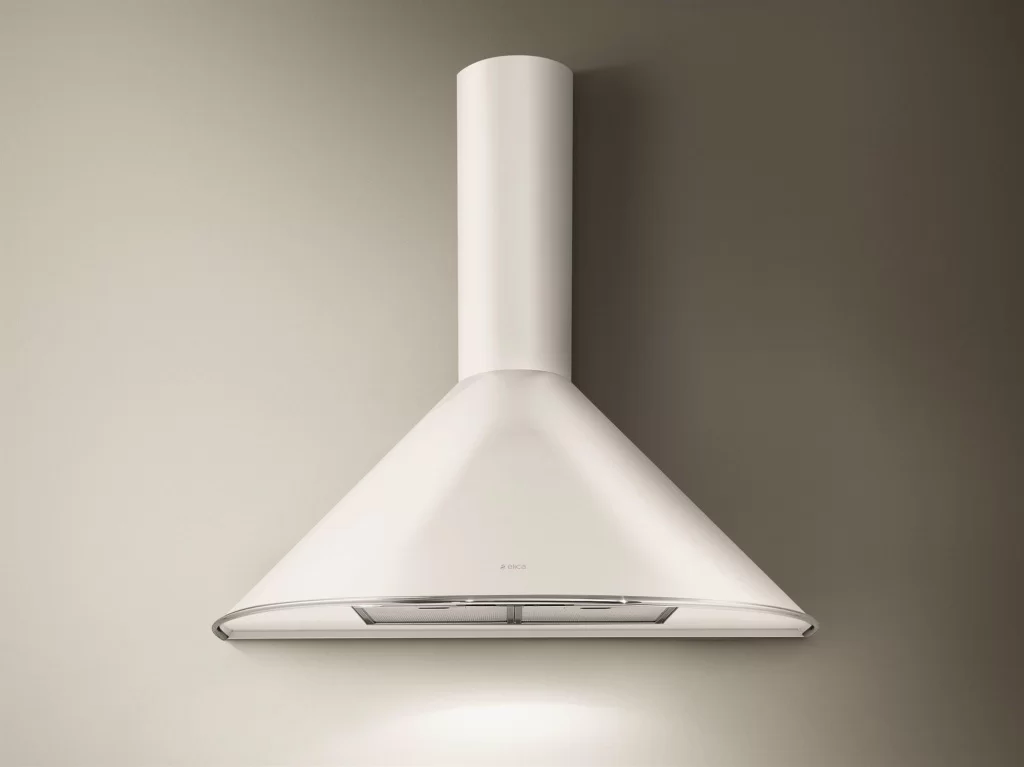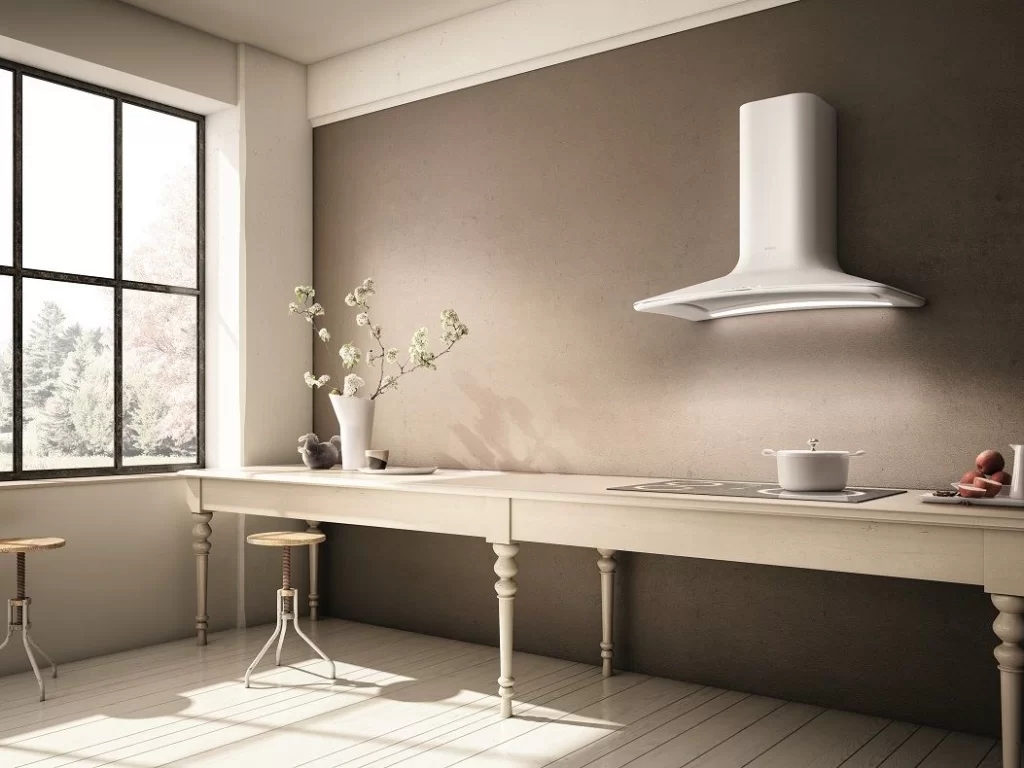
Which hood is better to choose — inclined or domed
The hood is a reliable, simple, functional device that plays an equally important role in the kitchen as well-chosen furniture or working tools. After all, it is it that allows you to eliminate all unpleasant odors and impurities that can settle on furniture, walls and ceilings. Which of the hood options is more efficient and easy to use? Our experts have figured it out.
Dome hoods

Device, principle of operation
Dome hoods, like any other, perform typical functions for this type of appliance: they purify the air from particles of grease, soot, smoke and absorb odors. The key visual difference between domed models is their cone-shaped (in some cases, rectangular or square) shape. The original appearance makes it possible to use dome hoods in everyday life, for professional purposes and even in country houses.
The dome hood has a wide lower part and a narrower upper part (attached to the ventilation of the device). The hood consists of several main elements:
-
Motor — sometimes 2 motors of different power;
-
Filters — grease-catching, capturing fat particles, and coal, neutralizing odors and providing fine air purification;
-
Fan — draws combustion products.
Dome hoods operate in one of two possible modes — on the principle of an air duct or recirculation. In the first case, the air after being drawn in is filtered and brought out through the ventilation pipes. In the second, the air after being drawn in is filtered and returned to the room.
Specificity, advantages
Dome hoods can be incredibly productive in the case of a competent ratio of their capabilities to the size of the room. In this case, the device is able to cope with any pollution and odors in the air (especially if it works in the air outlet mode).
How to determine the optimal performance of the device? It is enough to measure the area of the room and the height of the ceilings in it, and then multiply the obtained data with the air exchange coefficient. The result obtained is the desired performance. True, it is advisable to make a couple of corrections to the calculations: filters create an obstacle to air, as well as bends in the ventilation duct, which reduces power. Experts recommend increasing the result obtained in the calculations by 30%.
As for the design, the dome hood always looks very presentable. Most of the models on the market are made of stainless or enameled steel. There are also designer models made using several materials at once (for example, metal and glass).
Dome hoods are easy to operate, but during installation they require certain nuances to be observed. Firstly, it is important to correlate the dimensions of the product with the width of the stove: the structure should be slightly larger than the hob. Secondly, the device can only be mounted where there is access to the air duct (exit to the ventilation system of the building is required).
Main advantages:
-
High performance — the dome made in the form of a cone allows you to maximize the performance of the product (the power range of the device ranges from 400 to 1000 m3 / h, sometimes even higher).
-
Original design — dome products are presented in a huge variety of models: both ultra-modern options and unexpected retro models are available to consumers.
-
Versatility — the products have shown high efficiency in both the air outlet mode and the recirculation mode. Particularly high performance can be achieved with the air exhaust mode — recommended by experts for overall kitchens.
The main disadvantage of a dome appliance is its bulkiness, which makes it impossible to use in a small kitchen or with its non-standard layout.
Inclined hoods

Device, principle of operation
The internal structure of household appliances with an inclined screen is completely identical to any other hoods: dome, island, etc. Inside, the product is equipped with a working engine with a fan, several filters (grease trapping, coal), as well as a control system — touch or push-button (mechanical switches in such models of hoods do not apply).
The control panel is represented by a set of icons or buttons lined up in a row: their task is to start the device, select the optimal operating speed, or turn on the backlight if necessary.
The principle of operation of inclined household appliances is simple: panels located at a certain angle to the stove suck particles of fat and odors into the household appliance. Then the filter cleans the air and takes it out through the ventilation pipes or returns it to the room, having previously driven it through a carbon filter (recirculation mode). In the latter case, a periodic change of carbon filters (4-5 times a year) will be required.
A few words about the inclined draw fat cartridge. The element is made in the form of a multi-row aluminum (steel) mesh, which must be removed and washed as it gets dirty. You can clean the cartridge manually or with a dishwasher (the design provides for such a possibility).
Inclined models of kitchen hoods are distinguished by a variety of style and color solutions: thanks to the design features of the products, designers have many opportunities to create ergonomic, fashionable and at the same time functional appliances. For small hobs, the market offers hoods up to 45 cm wide, for standard hobs — up to 60 cm, for overall ones — up to 120 cm.
Consumers can choose both standard rectangular options and creative solutions: the front surface of such devices has a border, the screen often contains decorative glass inserts, sometimes there are models with a curved frontal plane.
Efficiency, benefits
Any hoods are not considered energy-intensive household appliances, but, nevertheless, the amount of energy consumed is worth considering. This is due to the fact that often different hoods with the same power can differ in performance. Sometimes there are low-power and incredibly functional devices: this is found only among inclined hoods. It’s all about the technology of their work.
Inclined devices work by the method of perimeter suction. Along the perimeter of the filter trapping fat particles there are holes of various diameters. When the air flow passes through them, it is accelerated, which improves the performance of the device.
Main advantages:
-
Stylish appearance — inclined versions of hoods are distinguished by a stylish design, elegance — they not only fit perfectly into the interior, but also act as a spectacular decor.
-
Convenient access to the stove — due to the location of the working part of the hood at an angle to the stove, the overall structure does not hang in front of the face.
-
Profitability with high functionality — air is sucked in during operation due to perimeter technology. Productivity is very high, and the product works quietly and economically.
We must not forget about the specific features of inclined hoods: the need for periodic replacement of the carbon filter and regular washing of the grease filter.
Criterias of choice

To choose the best hood option for your kitchen, you should pay attention to a couple of important details:
-
Dimensions — before choosing a hood of one size or another, you should take measurements of the kitchen and determine the installation location of the device.
-
Working principle — inclined products differ in the principle of operation: outlets remove air outside the housing; recirculation — let the trapped air pass and, after cleaning, return it to the room; mixed can work in any of the first two modes. You need to choose the appropriate option, strictly based on the characteristics of the room and your own needs.
-
Power — its minimum indicator should be 200 W, which is due to the peculiarity of the location of the working plane (at an angle): this requires considerable performance, otherwise the device simply will not be able to perform its main function.
-
Type of control — the choice of one or another option is strictly individual — touch, for example, is optimal when you want to maintain the integrity of the design.
Comparative characteristics
|
|
|
|
|
|
Air outlet, recirculation, combo option
|
Air outlet, recirculation, combo option
|
|
Performance
|
from 400 m3/h
|
from 400 m3/h
|
|
Filter types
|
Fat, coal (additional installation)
|
Fat, coal (additional installation)
|
|
Noise level
|
High (especially twin-engine), above 60 dB
|
Medium (below 60 dB)
|
|
type of instalation
|
On the wall, ceiling
|
On the wall, recessed mounting in furniture
|
|
Room size
|
Medium, large area
|
Any
|
Добавить комментарий
Для отправки комментария вам необходимо авторизоваться.